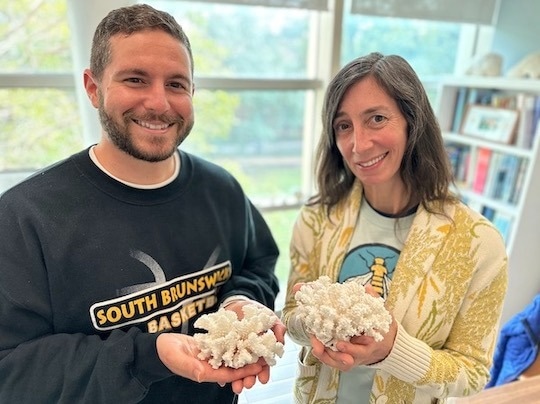The DNA of symbiotic creatures living within reef-building corals has been found to contain the remains of ancient RNA viruses by an international team of marine researchers.
 Rice Graduate Student Alex Veglia and marine biologist Adrienne Correa co-led a study that found fragments of non-retroviruses in the genomes of coral symbionts. Image Credit: Rice University
Rice Graduate Student Alex Veglia and marine biologist Adrienne Correa co-led a study that found fragments of non-retroviruses in the genomes of coral symbionts. Image Credit: Rice University
The symbionts were attacked by viruses as long ago as 160 million years ago, according to the RNA fragments. The finding, which is detailed in an open-access study published in the Nature journal Communications Biology, could help researchers better understand how corals and their companions now fend against viral infections.
However, the majority of RNA viruses are not known for encoding their genetic material into the DNA of the infected animals; therefore this discovery was unexpected.
The study demonstrated that endogenous viral elements, or EVEs, are broadly distributed in coral symbiont genomes. The single-celled algae that inhabit corals and give them their vivid hues are referred to as dinoflagellates.
The EVE finding confirms recent findings that viruses other than retroviruses can insert small pieces of their genetic code into the genomes of their hosts.
So why did it get in there? It could just be an accident, but people are starting to find that these ‘accidents’ are more frequent than scientists had previously believed, and they have been found across all kinds of hosts, from bats to ants to plants to algae.”
Adrienne Correa, Study Co-Author and Assistant Professor, BioSciences, Rice University
Another surprise was the existence of an RNA virus in coral symbionts at all.
This is what made this project so interesting to me. There is really no reason, based on what we know, for this virus to be in the symbionts’ genome.”
Alex Veglia, Study Lead Author and PhD Student, Rice University
Correa, Veglia, postdoctoral researcher Kalia Bistolas, and marine ecologist Rebecca Vega Thurber from Oregon State University conducted the study, which was funded by the Tara Ocean Foundation and the National Science Foundation.
The study offers hints that might aid in the understanding of the ecological and financial effects of viruses on the health of coral reefs.
In samples of filtered seawater or in the genomes of stony corals, hydrocorals, or jellyfish that do not include dinoflagellates, the researchers did not discover EVEs from RNA viruses.
However, the pathogenic viruses were—and presumably still are—selective about their target hosts as seen by the prevalence of EVEs in coral symbionts that were gathered from a variety of coral reef locations.
Correa, “There is a huge diversity of viruses on the planet. Some we know a lot about, but most viruses have not been characterized. We might be able to detect them, but we don’t know who serves as their hosts.”
She stated that retroviruses and other viruses had a variety of ways to proliferate via infecting hosts.
“One reason our study is cool is because this RNA virus is not a retrovirus. Given that, you wouldn’t expect it to integrate into host DNA. For quite a few years, we have seen a ton of viruses in coral colonies, but it’s been hard to tell for sure what they were infecting,” she added.
Correa further stated, “So this is likely the best, most concrete information we have for the actual host of a coral colony-associated virus. Now we can start asking why the symbiont keeps that DNA, or part of the genome. Why wasn’t it lost a long time ago?”
The fact that the EVEs have survived for millions of years raises the possibility that they could somehow benefit coral symbionts and that there is a mechanism underlying the genomic integration of the EVEs.
Veglia stated, “There are a lot of avenues we can pursue next, like whether these elements are being used for antiviral mechanisms within dinoflagellates, and how they are likely to affect reef health, especially as oceans warm.”
He added, “If we are dealing with an increase in the temperature of seawater, is it more likely that Symbiodiniaceae species will contain this endogenous viral element? Does having EVEs in their genomes improve their odds of fighting off infections from contemporary RNA viruses? In another paper, we showed there was an increase in RNA viral infections when corals underwent thermal stress. So, there are a lot of moving parts. And this is another good piece of that puzzle.”
Correa concluded, “We can’t assume that this virus has a negative effect. But at the same time, it does look like it’s becoming more productive under these temperature stress conditions.”
Thurber is the Emile F. Pernot Distinguished Professor of Microbiology at Oregon State University.
Source:
Journal reference:
Veglia, A. J., et al. (2023). Endogenous viral elements reveal associations between a non-retroviral RNA virus and symbiotic dinoflagellate genomes. Communications Biology. doi.org/10.1038/s42003-023-04917-9